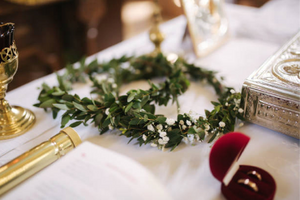Greek Orthodox Wedding Sacrament

Being born Greek and in Greece, a Greek Orthodox wedding was something that I was not necessarily used to seeing all the time, but an event that I didn’t have any questions about as it seemed so natural to me.
After my husband, who was not Greek or even Orthodox, asked for my hand in marriage, the only thing I asked of him was to be married in the Orthodox Church. At the time, I didn’t have any theological reasons as to why I asked for this. I grew up going to church regularly in Greece, but after moving to the US and at that time being in my 20s in the workforce, church was not a regular activity for me. Thinking back now, both my husband and I know that the guidance for my request came from above. My husband freely agreed to get married in the church, but he never asked me what happens during the Wedding Sacrament because, honestly, he didn’t know what to ask. I, on the other hand, didn’t feel that he needed any explanation.
My husband was expecting that the wedding would be about 20 minutes long and it would include the typical parts that we usually see at other weddings or on TV:
- The vows
- The exchange of rings
- Pronouncing the couple ‘husband and wife’
- Ending with a kiss.
Thankfully, the prewedding classes offered by the church took care of many of our questions. My husband learned that we didn’t exchange the traditional vows. This is, of course, something I knew about, but didn’t find it of much significance to mention. Although my husband was shocked to hear about it, we were both relieved that we didn’t have to write something and recite it in front of our quests. At the Rehearsal, our priest explained step-by-step all that would take place during the Sacrament. We were grateful and happy as this made for no surprises on the wedding day. Each step of the Wedding Sacrament was also described and explained to our guests after the sacrament was finished. Each step is so beautifully meaningful, so this was a gift to all present at church to hear what took place.
Thirty-three years later, owning an Orthodox Wedding business, I get asked many questions regarding the Wedding Sacrament and Traditions. I sure don’t have all the answers and am learning myself. I am thankful for the guidance of our Parish Priest, who is eager to provide the correct information regarding this sacrament. Whether you’re entering into Orthodoxy through marriage, seeking to better understand the sacrament, or simply curious, my hope is to breakdown the sacrament in a way to help better understand each step.
Please refer to the glossary provided for definitions of terms that will be frequently used throughout our blog.
The Wedding Sacrament
The Eastern Orthodox Church recognizes “Seven Sacraments,” which are and have been bestowed upon the church by Christ. The Orthodox Wedding ceremony is part of the Sacrament of Holy Matrimony. Matrimony blessed in the Church is not simply a secular or social event. It is a Sacrament in which the husband and wife receive God's grace and become sanctified agents of God's purpose in the marriage. The unity of the couple into one flesh is achieved by the work of the Holy Spirit. The service is divided into two parts: the betrothal and the marriage itself.
The Betrothal - Exchanging of the Rings

As the wedding service is celebrated in the Church today, the exchange of the rings is actually the celebration of the engagement. At the beginning of the betrothal, the priest confirms that the bride and groom wish to marry each other by simply asking them. After the priest has blessed the couple’s rings, the priest holds the rings together and rests them on the couple's forehead alternatively, while he declares the betrothal. He ends this portion of the service by placing the rings on the couple’s third finger of the right hand as a token of the lifelong union they are entering.
At this time, the koumbaro comes forth and exchanges the rings, placing the bride's ring on the groom's finger and back, three times. (Everything is always done in groupings of threes to represent the Holy Trinity - the Father, Son, and the Holy Spirit). The rings signify the devotion the spouses owe to each other, while the exchange of rings is symbolic of the promise each one commits to each other's needs in the presence of their official witness.
Previously this would have been a separate service (called the Arravona or pledge/promise i.e. engagement), but over time it has been linked to the marriage service. The Church knows only one blessing and wearing of rings, that which happens at the Arravvona, and the rings are put on the right hand in this service. The prayer associated with the blessing of the rings during the Arravona mentions the Right Hand of God delivering His people, and we know that the right hand is the hand used for giving blessings by the clergy as well as making the sign of the cross for ourselves. The Church places the rings on our right hand for good reasons. These should be taken into consideration before deciding to switch them to the left, which is the cultural practice in the United States.
Lighting of the Wedding Candles

The wedding ceremony begins immediately after the betrothal. It consists of a series of petitions and prayers where the priest asks God to grant the couple a long and peaceful life, respective love and support, and happiness for their children. The priest unites the hands of the bride and groom during the prayers signifying their unity into one flesh. A set of candles is lit and held by the couple. This is symbolizing the light of the purity of Christ that must be illustrated by their life. (Sometimes a second set of candles is lit and held by the koumbaro and koumbara. At this time, the large church candles are lit, if available.)
The Crowning

In comparison, the crowning follows next in a similar fashion as the betrothal. The priest holds the crowns as he did the rings. Alternating between the couple, he rests the crowns on the couple’s foreheads, always blessing in the shape of the cross, as he declares the marriage.
The bride and groom are crowned, as both martyrs and as the king and queen of their household to rule and serve one another with sacrifice, wisdom, justice, and integrity which are duties they pledge to God.
At this point, the koumbaro comes forth once more to exchange the crowns on top of the couple's heads three times, as his or her arms are crossed. The couple is left wearing the crowns which are connected with ribbon symbolizing their unity. This act of crowning is what marries the couple and for the remainder of the service they are referred to as “the newlyweds.”
Sharing the Common Cup

Holy scriptures and the Lord's prayer are recited with the blessing of the Common Cup of wine. In remembrance of the miracle in Cana, both the bride and groom sip wine from this shared cup, three times each. The common cup symbolizes the common life which they will both share.
This part of the sacrament is reminiscent of the first miracle of Christ in Cana. As Christ changed the water into wine, the power of the Sacrament changes the spouses from two to one.
Dance of Isaiah

The wedding ends with the dance of Isaiah. The bride and groom, with their hands together, wearing their united crowns and carrying the lit candles, are guided by the priest and followed by their sponsor, three times around the sacramental table which stands in front of them during the service.
As the priest leads the bride and groom, he holds the Gospel in his right hand as a reminder that the couple has chosen God to direct their new path in life. The koumbaro follows the couple holding the ribbon of their crowns symbolizing his support during their journey.
Sweet Memory: When we were dancing the 'Dance of Isaiah' my grandmother came up to throw rose petals and then decided to walk around with us. The priest allowed her. It was a very special moment, not planned as it is usually just the couple with their Koumbaro participating in the dance. The maid of honor helped by holding my dress.
Exchanging of Vows
It is not typical in Orthodox ceremonies to have an exchanging of vows as marriage is not a promise or a contract made between two parties, but the mystical union of two individuals resulting in one shared life. This union is the product of God’s grace upon the couple and the entirety of the service itself is focussed on his blessing upon the couple. Even though no vows take place during the Orthodox wedding sacrament, it is allowed for the groom and bride to share their first kiss before being introduced as newlyweds to their guests.
In conclusion, the Orthodox Wedding Sacrament is a profound union of love and faith and rich in tradition. From the betrothal to the crowning, each step symbolizes the spiritual bond between the couple and their commitment to each other and God.
What did you think? We would love to hear your thoughts and opinions!
- Terry Jacobson



Comments 0